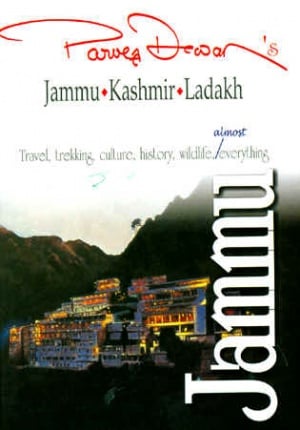Jammu Kashmir Ladakh
Jammu.Kashmir.Ladakh
While there have been a number of all-inclusive books about Kashmîr (from the 13th century Rajatarangini to the 19th century The Valley of Kashmîr and Tarîkh e Kashmîr) and Ladâkh (notably Cunnigham's Ladâk), there has never been a similar book about Jammû.
This is surprising because the 'Kashmîr' dispute is mostly about the occupied parts of Jammû province, which Pâkistân calls 'Azad' Jammû and Kashmîr. Even the wars of 1948, 1965 and 1971 have mainly taken place in Jammû province.
Parvez Dewan's Jammû: History, Culture, Travel, Trekking, Wildlife, (almost) Everything fills this gap. This massive, but easy to read, 615 page book is the final volume of his Jammû-Kashmîr-Ladâkh trilogy. Of particular interest is the detailed but riveting -page chapter about the violent happenings of 1947-49. Most Indian historians have ignored that unfortunate period, while Pâkistânis have published exaggerated accounts. Pâkistân claims that almost two lakh Jammû Muslims were killed in those riots-and an even larger number migrated.
In order to arrive at the truth, Dewan has examined census records (1931-2001) and also collected a number of gripping anecdotes from the families of the victims of that violent era-Hiñdu, Muslim and Sikh.
He has also covered every important battle fought in Jammû province after 1947, making this book a must-read for army officers as well as those interested in the history of Pâkistân's wars with India
Dewan not only brings the history of Jammû province up to date, he has drawn upon 20th century archaeological discoveries to trace the pre-history of Jammû. There are separate chapters on the histories of Kishtwar, Poonch and Rajouri, as well as brief histories of the other principalities of Jammû province, especially Kathua, Udhampur, Bhaderwah, Doda, Basohli and Ramnagar. There is also a brief history of the so-called 'Âzâd' Jammû and Kashmîr.
Dewan has woven interesting anecdotes from the era of the Dogra maharajas into two nostalgic chapters about Jammû's fabled composite culture, where Hiñdus and Muslims went to the same shrines and 'godmen,' ate the same food and thought the same thoughts.
The book is essentially a guide for tourists. It lists in detail the tourist attractions-beauty spots as well as temples, shrines and forts-of the six districts of Jammû. It also gives details about the delicious Dogra food sold on the Jammu-Srinagar National Highway, from the yellow rice of Lakhanpur-Samba to the rajma of Peerah.
This is also the first book about the people of Jammû province. Dewan has tried to provide the essential details about every Hiñdu, Muslim and Sikh clan and sub-caste of the province, including the parts under the occupation of Pâkistân. There are two chapters for pilgrims to the holy shrine of Shri Mâtâ Vaishno Dévî jî. The story of the Deity as well as details about the pilgrimage have been provided. Shahdra Sharief receives the second largest number of pilgrims in Jammû. There is a detailed chapter about the history of the shrine as well as the pilgrimage.
In addition, the book has information about the various important Hiñdu, Muslim and Sikh pilgrimages, shrines and festivals of the province, including some known only within the tehsil.
There is a chapter about the Sikhs of Jammû and Kashmîr and another one about Sikhism in Pooñch-Rajourî (and Kashmîr).
The rich cultural heritage of Jammû has seldom been covered so thoroughly. There is a chapter each about the Handicrafts of Jammu, the Basohli School of Miniature Painting (which Dewan had revived in his first posting as an IAS officer), the lesser known miniature painting schools, Wellside Sculpture and the performing arts: song, dance and theatre.
The wildlife of Jammû has also rarely been written about. Therefore, people assume that Jammû has none. Jammûites know about the sacred groves of Kerala but not their own.
Jammû province, especially Kishtwar, has some of the highest mountain peaks and finest trekking routes in the world. Rajouri district could well be called the lake district of India. And yet even Jammûites are unaware of this. Dewan fills this gap as well. Similarly he has charted the courses of all the major rivers of Jammû, in particular the stretches where river rafting is possible.
In all, this encyclopædic but easy to read book is a must for the bookshelves of everyone who cares about Jammû province-or about the Kashmîr issue.
(Parvez Dewan is an IAS officer of the Jammû and Kashmîr cadre. He was educated at St. Stephen's, Delhi and the University of Cambridge and was elected a research fellow of Queen Elizabeth House, Oxford. At present he is the Chairman of the India Tourism Development Corporation.)

